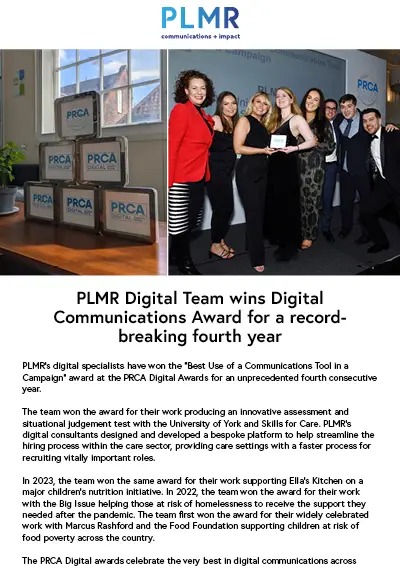In whichever sector you operate, at some point you will typically encounter some industry awards. The ones that offer guests a three-course meal, with entertainment and a prominent local, public or celebrity compering.
Most importantly though, they provide a host of awards in a range of categories celebrating winning entrants’ successes and industry-leading approaches on a given topic.
Aside from the personal satisfaction of winning an award, picking up such prizes is pretty valuable promotional currency. They act as a piece of self-marketing or business marketing collateral, allowing a company or an individual to accurately describe themselves as ‘award-winning’, evidenced by a shiny logo in their email signature or on their website.
However, before you can start drafting the acceptance speech, first must come the entry to the award organisers.
To help you get started, here are some simple steps to follow and top tips to draft the perfect award entry.
Why am I entering this award?
Our guide starts with a broad question, but one which informs the hours you will set aside when drafting an entry. You should ask yourself, it this award worth myself or my company pursing? It is important any award you enter links to your overall goals and strategy and is widely-known among your target audiences.
Remember, your audience are the ones you are trying to dazzle here. Allocating time and resources to an award entry which diverges from your strategy, one unlikely to wow your target audience, or one that nobody has never even heard of is typically one to avoid.
Winning a niche award can boost your ego, but it must first of all boosting your profile among those you are trying to reach.
What are the judges looking for?
Just like Craig, Shirley, Motsi and Anton on Strictly Come Dancing, award judges always have a firm set of criteria on what they expect to see in an entry. In the case of sector awards, they help you by sharing this information on the awards’ entry form along with an accompanying word count and deadline.
Whatever you decide to write in your entry, it must link to what the judges are actually looking for. The key to successfully achieving this are planning and timing.
Start by familiarising yourself with the awards in advance, this saves you from being caught out by an upcoming deadline. You should then thoroughly read the entry criteria, firstly to ensure you are eligible to enter, and then to start planning your way to hitting the judges’ key points.
How do I gather the information I need?
The process of gathering information can be the most time-consuming part, and will require you to go through the last twelve months with a fine toothcomb to pick relevant examples to show how you have been award-winning.
Kick things off with outline bullet points to meet each of the judges’ requirements at first, and then start to put time aside based on the word count and information you already have on file.
As you start to draft more entries, for similar awards, you will be able to deploy time savers like developing entry templates or re-using particularly strong entries which can be helpful.
How do I structure my entry?
It is important to have a flow and journey for the reader to accurately portray the excellent work you have been carrying out. One way of letting your entry breathe is to use subheadings to separate text, giving the reader a chance to absorb the information.
You should start with an introduction, include an evaluation of the initiatives deployed and actions discussed in your entry, and make sure you note any future plans related to develop your work.
A simple formula to follow is the STAR method:
- Situation
- Task
- Action
- Result
How do I make my entry stand out?
Remember, the person you are trying to convince has probably never set foot inside of your building and are probably reading a number of broadly similar entries from your competitors. Standing out among the judges is your best chance of securing your passport to the trophy presentation.
Whilst it is important to reflect on your own achievements, you should also consider what your competitors have accomplished over the past 12 months. You will then be able to realistically define what you have done that is unique and sector-leading.
Just as we highlighted the importance of using awards to attract your target audience, they also hold the key to demonstrating your impact. Making your entry stand out also comes from placing a focus on the impact and result of your work for clients and people you support. What results have your efforts heralded? How have your clients or people you support benefited from this?
Another top tip to making your entry stand apart, is to fully explain less examples of your work, but ensuring each explanation links back to the objective you set when introducing an initiative, and how measuring its impact against said objective.
Finishing touches
Once the content is there, we move how it is presented along with some final finishing touches. Whilst it may be tempting to bring out Picasso’s paint palette, and showing off with a full array of fonts, over complicating your formatting will not curry favour with the judges.
With some award providers, they even accept entries through an online portal. Thereby invalidating complex colour schemes you may wish to incorporate. Our advice is to therefore present your entry in a clear and accessible manner, avoiding the temptation to over complicating formatting.
One last way of knitting the entire entry together and hitting key points outlined in this blog is using a range of materials as supporting evidence.
Whether it is pieces of imagery or videos which underline your activities over the last 12 months, testimonials written from your clients or people you support, this adds authenticity and an external voice to your entry.




